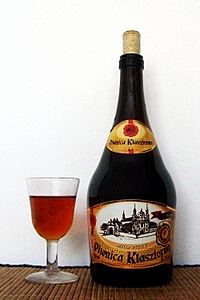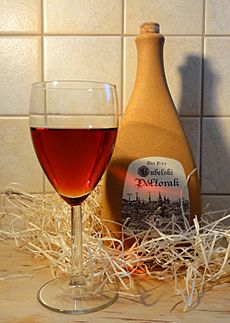Mead in Poland facts for kids

A bottle and a glass of trójniak mead
|
|
| Type | Mead |
|---|---|
| Country of origin | Poland |
| Introduced | Middle Ages |
| Alcohol by volume | 9–18% |
| Colour | Golden to dark amber |
| Flavour | Honey |
| Ingredients | Honey, water |
| Variants | Fruit, herbal, spiced |
Mead (Polish: miód pitny [mʲut ˈpʲitnɨ], literally "drinkable honey") is an alcoholic beverage within Polish culinary tradition made by alcoholic fermentation of a mixture of honey and water. It has a characteristic honey aroma and a flavour that may be enriched by the addition of fruit juices, herbs or spices. The colour ranges from golden to dark amber, depending on the type of honey used for production.
In 2008, four traditional Polish mead grades, which indicate the proportion of honey and water used in production, were registered by the European Union as a traditional speciality guaranteed. Production of mead in Poland almost doubled within the next four years, making Poland the world's largest producer of mead made according to traditional methods.
Contents
Grades and varieties
Polish meads are traditionally and legally classified into four grades (czwórniak, trójniak, dwójniak, półtorak) depending on the ratio of honey and water used in production and the resulting sweetness and alcohol content. Their names come from the total number of parts by volume of honey and water, with one part being honey; for example, czwórniak is made from one part honey and three parts water, giving a total of four parts. The lower the total number of parts, the stronger, sweeter and more expensive the mead. Informal honey-to-water proportions, such as półtrzeciak (1:1.5) or sześciak (1:5), may be used in home production, but are not commercially available due to legal restrictions.
| Grade | Polish pronunciation | Meaning | Honey-to-water ratio (vol:vol) | Alcohol content by volume | Reducing sugars after inversion | Sweetness | Min. ageing time |
|---|---|---|---|---|---|---|---|
| Czwórniak | [ˈt͡ʂfurɲak] | Four parts | 1:3 | 9–12% | 35–90 g/L | dry | 9 months |
| Trójniak | [ˈtrujɲak] | Three parts | 1:2 | 12–15% | 65–120 g/L | semi-sweet | 1 year |
| Dwójniak | [ˈdvujɲak] | Two parts | 1:1 | 15–18% | 175–230 g/L | sweet | 2 years |
| Półtorak | [puwˈtɔrak] | One and a half parts | 2:1 | 15–18% | > 300 g/L | dessert | 3 years |
Mead may be flavoured with fruit juices, producing fruit mead (miód owocowy), or with herbs and spices, giving herbal mead (miód ziołowy) or spiced mead (miód korzenny). Traditional varieties, distinguished according to the raw materials and natural additives used or to the method of ageing, include:
- agrestniak, flavoured with gooseberry juice;
- borówczak, flavoured with lingonberry juice;
- czereśniak, flavoured with sweet cherry juice;
- czerniak, flavoured with bilberry juice;
- dębniak, matured in oak barrels;
- dereniak, flavoured with Cornelian cherry juice;
- gruszeczniak, flavoured with pear juice;
- jabłczak, flavoured with apple juice;
- jarzębiak, flavoured with rowanberry juice;
- jeżyniak, flavoured with blackberry juice;
- kaliniak, flavoured with guelder rose juice;
- lipiec, made from linden honey;
- maliniak, flavoured with raspberry juice;
- miód chmielowy, flavoured with hops;
- miód gronowy, flavoured with grape juice;
- morwiak, flavoured with mulberry juice;
- porzeczniak, flavoured with currant juice;
- poziomczak, flavoured with woodland strawberry juice;
- śliwniak, flavoured with plum juice;
- wiśniak, flavoured with sour cherry juice.
Other popular flavouring ingredients include celery leaves, cinnamon, cloves, elderberries, ginger, juniper berries, rose oil and vanilla.
Production
Mead is made by fermentation of must, which is a mixture of honey and water, the proportion of which depends on the required grade. In the cases of dwójniak and półtorak, the sugar concentration would be too high for the yeast to work in the fermentation process, so the must is prepared with one part honey to two parts water; the rest of the honey is added in the final stage of fermentation or during aging. For fruit meads, at least 30 percent of the water is replaced with fruit juice; herbs or spices may be added as well.
In commercial production, the must is usually boiled at a temperature of 95–105 °C, giving what is known in Polish as miód sycony (saturated mead). The required extract is obtained in a kettle fitted with a steam jacket. This method of brewing prevents caramelization of the sugars. Miód niesycony (unsaturated mead) is also made, especially in home production, wherein the must is made by mixing honey with room temperature or warm water, without boiling, allowing to retain more of the honey aroma.
In order to guarantee the microbiological safety of the boiled must, it is cooled on the same day to 20–22 °C, the optimum temperature for yeast to propagate. A yeast solution is then added to the must in a fermentation tank in a process known as "pitching". Violent fermentation takes 6–10 days. Keeping the temperature at a maximum level of 28 °C ensures that the fermentation process runs properly. This is followed by still fermentation, which takes 3–6 weeks. At this stage, it is possible to add the remaining quantity of honey to achieve the proportion required for dwójniak or półtorak.
After obtaining an alcohol content of at least 12 percent by volume, the mead undergoes racking prior to aging. Leaving the pitched must on the lees beyond the still fermentation period would adversely affect the mead's organoleptic properties because of yeast autolysis. Aging (maturing) and siphoning (decantation) is repeated as necessary to prevent unwanted processes from taking place in the lees. During aging, it is possible to carry out pasteurization and filtration. This stage is essential for ensuring that the product has the right organoleptic properties.
The flavor of the final product may be adjusted by adding honey to sweeten the mead, addition of herbs and spices or ethanol of agricultural origin. Bottling takes place at a temperature of 18–25 °C. Traditional carboys, ceramic bottles or oak barrels are typically used.
Serving
In Poland, mead is most commonly served at room temperature in a glass or a stoneware cup. Depending on the weather, it may be also drunk chilled to about 12°C or warm. On a hot day, chilled mead may be served with mint or a lemon slice. In winter some Poles enjoy mulled mead, which may be additionally flavoured with cloves, cinnamon, vanilla, ginger, black pepper or a slice of orange.
History

Mead production and consumption in Poland is a tradition that stretches back for centuries. In the Middle Ages, Poland was covered with primeval forests, which the 12th-century chronicler Gallus Anonymus described as "flowing with honey". This abundance of honey and a climate ill-suited for grape growing meant that mead was long more popular than wine. In 996, the Sephardi Jewish traveller Ibrahim ibn Yaqub wrote that "besides food, meat and land for ploughing, the country of Mieszko I abounds in mead, which is what the Slavic wines and intoxicating drinks are called". In the 15th century, the Venetian diplomat Ambrogio Contarini observed that "having no wine, [the Poles] make a certain drink out of honey, which intoxicates people much more than wine." The 16th-century Polish poet Sebastian Klonowic praised the "nutritious and healthy" mead of Ruthenia (then part of Poland, now in western Ukraine) as a "nectar" worthy of Olympian gods, as opposed to wine.
Wine comes from the earth muddy and grey,
Mead must be sent down straight from the heavens.
Notwithstanding the popular notion that mead used to be the everyday drink in Poland, it has always been a luxury good, reserved for special occasions, such as weddings, and available only to the affluent, while beer was the daily thirst quencher of the common people. Mead was valuable enough to be deemed a suitable gift for monasteries and dignitaries.
The oldest known recipe for mead was recorded in 1567 by the Swedish chronicler Olaus Magnus, who obtained it from a native of the Polish city of Gniezno. According to it, ten pounds of honey were to be boiled with forty pounds of water, flavoured with hops and fermented with beer yeast or bread starter. As well as with hops, 17th-century Polish mead was flavoured with fennel, pepper, cloves, cinnamon, anise, poppy seeds or parsley. Source materials describing Polish culinary traditions of the 17th and 18th centuries contain not only general mentions of mead, but also references to different types of it. The terms czwórniak, trójniak, dwójniak and półtorak date back to this period. Mead was produced and served in meaderies, known in Polish as miodosytnie, which were marked with a red cross above the door to distinguish them from beerhouses, marked with a straw wisp, and from wineshops, marked with a wreath.
Around the 17th century mead started to lose popularity to wine imported from the south, especially from Hungary, and domestically produced vodka. In the 19th century it came to be associated with the bygone times of pre-partition Poland, as evidenced by its mentions in the Polish national epic poem Pan Tadeusz by Adam Mickiewicz, in the poems of Tomasz Zan and in the Trilogy of historical novels by Henryk Sienkiewicz.


